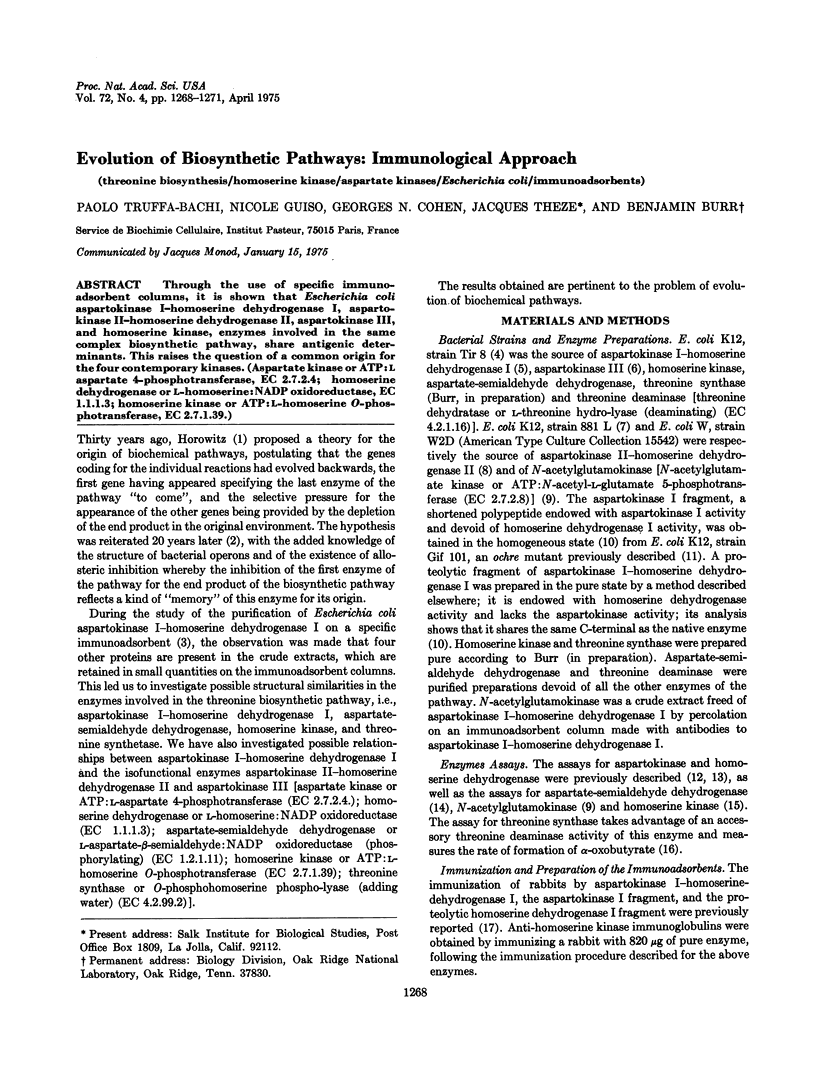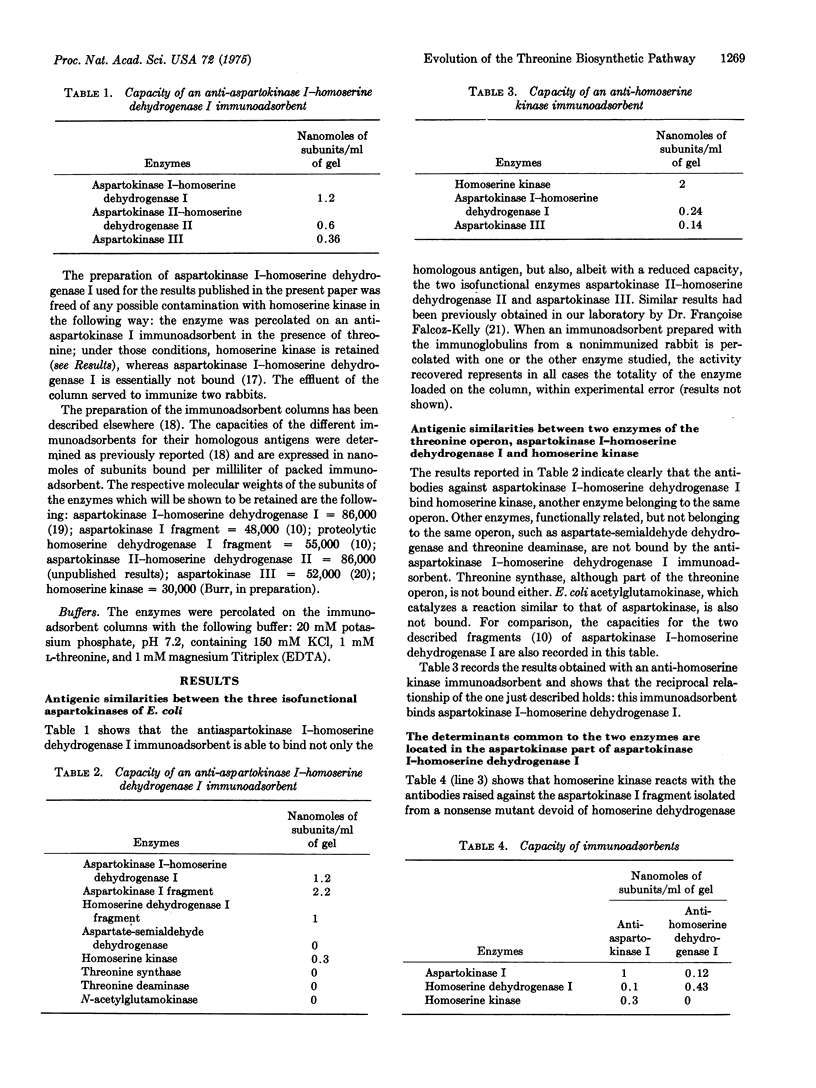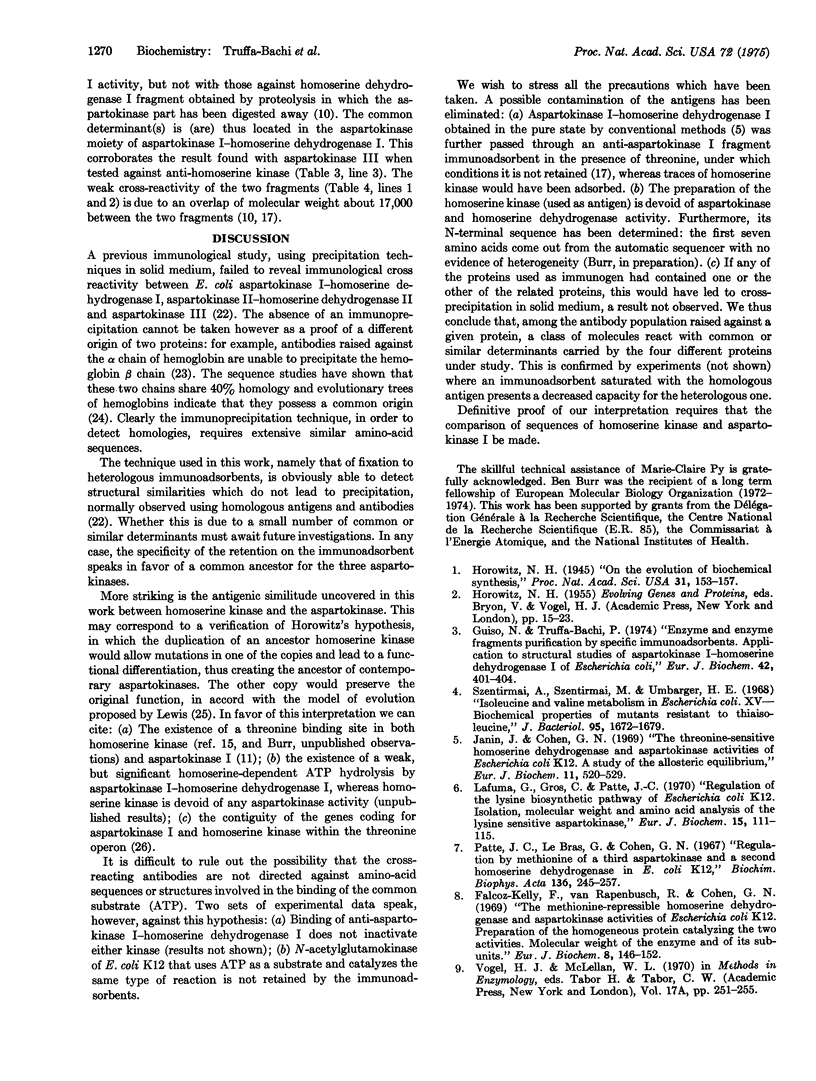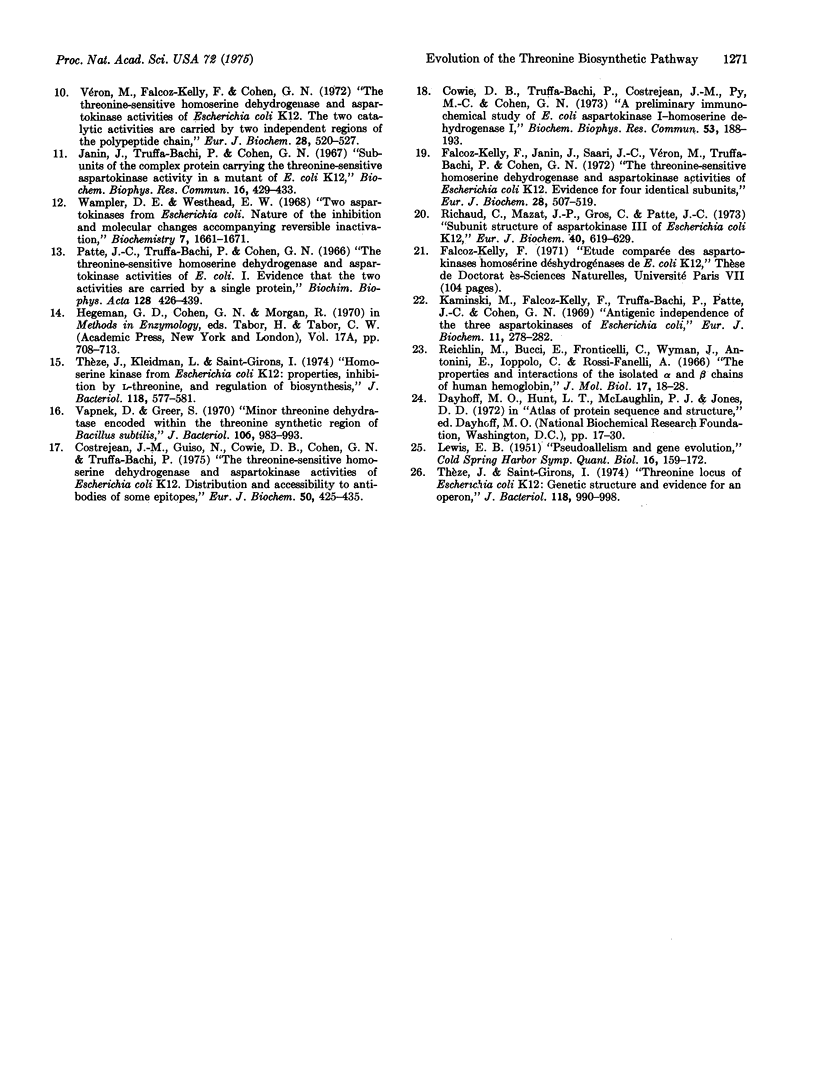Abstract
Through the use of specific immunoadsorbent columns, it is shown that Escherichia coli aspartokinase I-homoserine dehydrogenase I, aspartokinase II-homoserine dehydrogenase II, aspartokinase III, and homoserine kinase, enzymes involved in the same complex biosynthetic pathway, share antigenic determinants. This raises the question of a common origin for the four cibtenoirart kinases. (Aspartate kinase or ATP:L aspartate 4-phosphotransferase, EC 2.7.2.4; homoserine dehydrogenase or Lhomoserine:NADP oxidoreductase, EC 1.1.1.3; homoserine kinase or ATP:L-homoserine O-phosphotransferase, EC 2.7.1.39.)
Full text
PDF



Selected References
These references are in PubMed. This may not be the complete list of references from this article.
- Costrejean J. M., Guiso N., Cowie D. B., Cohen G. N., Truffa-Bachi P. The threonine-sensitive homoserine dehydrogenase and aspartokinase activities of Escherichia coli K12. Distribution and accessibility to antibodies of some epitopes of the bifunctional enzyme. Eur J Biochem. 1975 Jan 2;50(2):431–435. doi: 10.1111/j.1432-1033.1975.tb09820.x. [DOI] [PubMed] [Google Scholar]
- Cowie D. B., Truffa-Bachi P., Costrejean J. M., Py M. C., Cohen G. N. A preliminary immunochemical study of E. coli aspartokinase I-homoserine dehydrogenase I. Biochem Biophys Res Commun. 1973 Jul 2;53(1):188–193. doi: 10.1016/0006-291x(73)91418-6. [DOI] [PubMed] [Google Scholar]
- Falcoz-Kelly F., Janin J., Saari J. C., Véron M., Truffa-Bachi P., Cohen G. N. Revised structure of aspartokinase I-homoserine dehydrogenase I of Escherichia coli K12. Evidence for four identical subunits. Eur J Biochem. 1972 Aug 4;28(4):507–519. doi: 10.1111/j.1432-1033.1972.tb01938.x. [DOI] [PubMed] [Google Scholar]
- Falcoz-Kelly F., van Rapenbusch R., Cohen G. N. The methionine-repressible homoserine dehydrogenase and aspartokinase activities of Escherichia coli K 12. Preparation of the homogeneous protein catalyzing the two activities. Molecular weight of the native enzyme and of its subunits. Eur J Biochem. 1969 Mar;8(1):146–152. doi: 10.1111/j.1432-1033.1969.tb00507.x. [DOI] [PubMed] [Google Scholar]
- Guiso N., Truffa-Bachi P. Enzyme and enzyme fragments purification by specific immunoadsorbents. Application to structural studies of aspartokinase I-homoserine dehydrogenase I of Escherichia coli. Eur J Biochem. 1974 Mar 1;42(2):401–404. doi: 10.1111/j.1432-1033.1974.tb03352.x. [DOI] [PubMed] [Google Scholar]
- Horowitz N. H. On the Evolution of Biochemical Syntheses. Proc Natl Acad Sci U S A. 1945 Jun;31(6):153–157. doi: 10.1073/pnas.31.6.153. [DOI] [PMC free article] [PubMed] [Google Scholar]
- Janin J., Cohen G. N. The threonine-sensitive homoserine dehydrogenase and aspartokinase activities of Escherichia coli K 12. A study of the allosteric equilibrium. Eur J Biochem. 1969 Dec;11(3):520–529. doi: 10.1111/j.1432-1033.1969.tb00804.x. [DOI] [PubMed] [Google Scholar]
- Janin J., Truffa-Bachi P., Cohen G. N. Subunits of the complex protein carrying the threonine-sensitive aspartokinase activity in a mutant of Escherichia coli K 12. Biochem Biophys Res Commun. 1967 Feb 21;26(4):429–434. doi: 10.1016/0006-291x(67)90564-5. [DOI] [PubMed] [Google Scholar]
- Kaminski M., Falcoz-Kelly F., Truffa-Bachi P., Patte J. C., Cohen G. N. The antigenic independence of the three aspartokinases of Escherichia coli K 12. Eur J Biochem. 1969 Dec;11(2):278–282. doi: 10.1111/j.1432-1033.1969.tb00770.x. [DOI] [PubMed] [Google Scholar]
- LEWIS E. B. Pseudoallelism and gene evolution. Cold Spring Harb Symp Quant Biol. 1951;16:159–174. doi: 10.1101/sqb.1951.016.01.014. [DOI] [PubMed] [Google Scholar]
- Lafuma C., Gros C., Patte J. C. Regulation of the lysine biosynthetic pathway of Escherichia coli K12. Isolation, molecular weight and amino acid analysis of the lysine sensitive aspartokinase. Eur J Biochem. 1970 Jul;15(1):111–115. doi: 10.1111/j.1432-1033.1970.tb00983.x. [DOI] [PubMed] [Google Scholar]
- Patte J. C., Le Bras G., Cohen G. N. Regulation by methionine of the synthesis of a third aspartokinase and of a second homoserine dehydrogenase in Escherichia coli K 12. Biochim Biophys Acta. 1967 Mar 22;136(2):245–247. doi: 10.1016/0304-4165(67)90069-4. [DOI] [PubMed] [Google Scholar]
- Reichlin M., Bucci E., Fronticelli C., Wyman J., Antonini E., Ioppolo C., Rossi-Fanelli A. The properties and interactions of the isolated alpha- and beta-chains of human haemoglobin. IV. Immunological studies involving antibodies against the isolated chains. J Mol Biol. 1966 May;17(1):18–28. doi: 10.1016/s0022-2836(66)80091-8. [DOI] [PubMed] [Google Scholar]
- Richaud C., Mazat J. P., Gros C., Patte J. C. Subunit structure of aspartokinase 3 of Escherichia coli K12. Eur J Biochem. 1973 Dec 17;40(2):619–629. doi: 10.1111/j.1432-1033.1973.tb03234.x. [DOI] [PubMed] [Google Scholar]
- Szentirmai A., Szentirmai M., Umbarger H. E. Isoleucine and valine metabolism of Escherichia coli. XV. Biochemical properties of mutants resistant to thiaisoleucine. J Bacteriol. 1968 May;95(5):1672–1679. doi: 10.1128/jb.95.5.1672-1679.1968. [DOI] [PMC free article] [PubMed] [Google Scholar]
- Thèze J., Saint-Girons I. Threonine locus of Escherichia coli K-12: genetic structure and evidence for an operon. J Bacteriol. 1974 Jun;118(3):990–998. doi: 10.1128/jb.118.3.990-998.1974. [DOI] [PMC free article] [PubMed] [Google Scholar]
- Théze J., Kleidman L., St Girons I. Homoserine kinase from Escherichia coli K-12: properties, inhibition by L-threonine, and regulation of biosynthesis. J Bacteriol. 1974 May;118(2):577–581. doi: 10.1128/jb.118.2.577-581.1974. [DOI] [PMC free article] [PubMed] [Google Scholar]
- Véron M., Falcoz-Kelly F., Cohen G. N. The threonine-sensitive homoserine dehydrogenase and aspartokinase activities of Escherichia coli K12. The two catalytic activities are carried by two independent regions of the polypeptide chain. Eur J Biochem. 1972 Aug 4;28(4):520–527. doi: 10.1111/j.1432-1033.1972.tb01939.x. [DOI] [PubMed] [Google Scholar]
- Wampler D. E., Westhead E. W. Two aspartokinases from Escherichia coli. Nature of the inhibition and molecular changes accompanying reversible inactivation. Biochemistry. 1968 May;7(5):1661–1671. doi: 10.1021/bi00845a007. [DOI] [PubMed] [Google Scholar]


